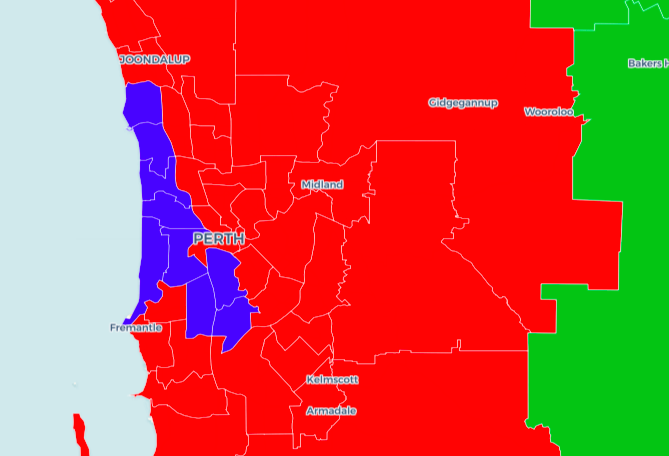Western Australia conducts redistributions of the state electoral boundaries every four years, so each election sees a new set of electoral boundaries.
The recent redistribution did not see any dramatic changes in seats. We did not see a rural seat abolished and replaced by a new urban seat, as has happened in previous redistributions. The six upper house regions still cover roughly the same area and cover the same number of electorates. Just one seat was changed sufficiently to require a change in name.
This map shows the electorates. You can click on each seat to see how the margin has changed.
I posted about these final margins on my blog in February 2020. You can see the full list of old and new margins there, along with links to the alternative calculations from Antony Green and William Bowe, which are mostly very similar.
The seat of Girrawheen was renamed Landsdale. 59% of voters in the new Landsdale were previously contained in Girrawheen. The neighbouring seat of Mirrabooka only contains 57% of its previous population, while West Swan only contains 61% of its previous population. Overall 8.5% of voters have been moved to a new seat.
Nine seats experienced no population change: Armadale, Belmont, Forrestfield, Geraldton, Kalgoorlie, Maylands, Mount Lawley, Southern River, Thornlie and Warnbro.
Overall the changes made little impact to the shape of the pendulum. Prior to the redistribution, a uniform swing of 5.8% against Labor would see Labor lose twelve seats and their majority. The uniform swing now required is 5.9%.
There are ten seats where the margin changed by more than 2%. Five Labor incumbents saw their margins strengthened: by 2.1% each in Balcatta and West Swan, by 2.7% in Willagee, by 3% in Kwinana and by 4.4% in Mirrabooka. Four Labor incumbents lost ground: by 2.2% in Cockburn, by 2.7% in Swan Hills, by 3.5% in Baldivis and by 7% in Girrawheen/Landsdale. The Liberal seat of Hillarys saw the margin cut from 4.1% to 0.1%.
Overall this was a relatively modest redistribution without massive impacts. The Commission made a decision not to eliminate any rural seats, meaning that urban seats have been drawn a bit larger than is strictly necessary. I suspect this means we will see an additional urban seat created in the next redistribution, with more significant knock-on effects.



